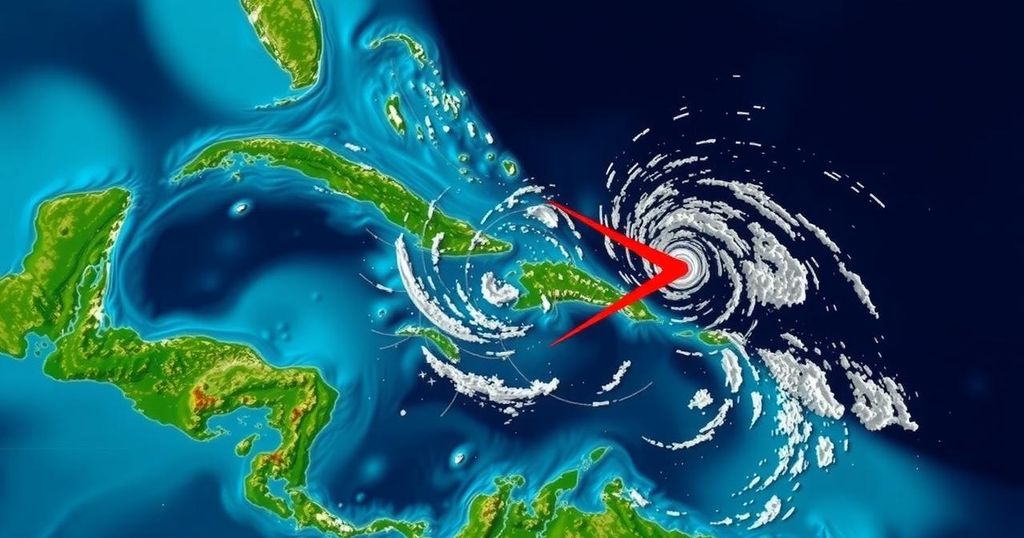Tropical Storm Oscar Nears the Bahamas After Causing Devastation in Cuba
Tropical Storm Oscar moved towards the Bahamas following its landfall in Cuba as a Category 1 hurricane, resulting in at least six fatalities due to heavy rainfall. The storm, characterized as one of the smallest hurricanes ever recorded, has caused severe flooding and complicates Cuba’s recovery from a massive blackout. A tropical storm warning is in effect for parts of the Bahamas. Meanwhile, Kristy is also gaining strength in the Pacific Ocean.
Tropical Storm Oscar is advancing towards the Bahamas after having made landfall in Cuba as a Category 1 hurricane, resulting in the tragic loss of at least six lives due to its associated heavy rains. As of Tuesday morning, Oscar was situated approximately 45 miles (75 kilometers) south-southeast of Long Island in the Bahamas, with recorded winds of 40 mph (65 kph) and a movement trajectory directed north-northeast at a rate of 12 mph (19 kph) as reported by the National Hurricane Center based in Miami. In light of the storm’s diminished intensity, the National Hurricane Center described Oscar as “barely a tropical storm at this time.” Forecasts indicate that the southeastern Bahamas could receive precipitation ranging from 5 to 8 inches (13 to 20 centimeters) in isolated regions. Consequently, a tropical storm warning has been issued for the central and southeastern sections of the Bahamas. Oscar has made history by being the smallest hurricane recorded, with a wind field measuring merely 6 miles (10 kilometers) across. Its unexpected intensification into a hurricane caught many meteorological experts off guard, as Michael Lowry, an esteemed hurricane specialist, remarked, “It’s not often we see a colossal failure in hurricane forecasting.” This unexpected surge in intensity led to two landfalls: one on Grand Inagua Island in the Bahamas on Saturday and another on eastern Cuba late Sunday. In Cuba, Oscar caused significant rainfall, with parts of eastern Cuba receiving reports of over 15 inches (38 centimeters), prompting warnings of severe flooding along with risks of landslides. The deaths occurred primarily in the region of Guantánamo. The storm’s timing is particularly unfortunate, as Cuba is grappling with the aftermath of a massive blackout, which has already ignited small protests and stern government warnings against unrest. As the 15th named storm and 10th hurricane of the Atlantic hurricane season—which commenced on June 1 and will conclude on November 30—Oscar adds to the active year. Anticipating a heightened level of activity, the National Oceanic and Atmospheric Administration has predicted an above-average hurricane season due to unprecedented warm ocean temperatures, estimating the occurrence of 17 to 25 named storms, with four to seven categorized as major hurricanes (Category 3 or higher). Furthermore, Tropical Storm Kristy was identified over open waters in the Pacific Ocean, located 375 miles (605 kilometers) west-southwest of Acapulco, Mexico, with sustained winds of 50 mph (85 kph), projected to evolve into a hurricane by the evening of the same day.
Hurricane forecasting plays a critical role in disaster preparedness and response, significantly impacting how communities prepare for and respond to severe weather events. While meteorological models strive to predict storm paths and intensities, there remain instances where unexpected developments challenge existing forecasts, as seen with Tropical Storm Oscar. The 2023 Atlantic hurricane season has been characterized by heightened storm activity, underscoring the importance of ongoing research and advancements in predictive meteorology to minimize human casualties and property damage.
In summary, Tropical Storm Oscar, which has transitioned from a Category 1 hurricane to a minimal tropical storm, has left a toll of at least six fatalities in Cuba due to extensive rainfall and flooding. As it continues towards the Bahamas, it exemplifies the unpredictable nature of storm formation and intensification, emphasizing the need for robust hurricane forecasting methods. With an exceptionally active hurricane season observed this year, vigilance and preparation become paramount for coastal communities.
Original Source: www.washingtontimes.com




Post Comment